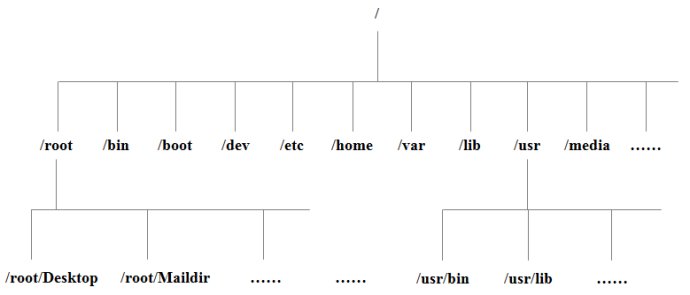Linux system directory structure
After logging in to the system, enter the command in the current command window:
ls /
You will see the following picture:
Tree directory structure:

The following is an explanation of these directories:
/bin:
bin is the abbreviation of Binary. This directory stores the most frequently used commands./boot:
This stores some core files used when starting Linux, including some connection files and image files./dev:
dev is the abbreviation of Device. This directory stores Linux external devices. Access the device in Linux. The way to access files is the same./etc:
This directory is used to store all configuration files and subdirectories required for system management./home:
The user’s home directory. In Linux, each user has his own directory. Generally, the directory name is based on the user named after the account./lib:
This directory stores the most basic dynamic link shared library of the system, and its function is similar to the DLL file in Windows. Almost all applications require use of these shared libraries./lost+found:
This directory is usually empty. When the system is shut down illegally, some files are stored here./media The Linux system will automatically recognize some devices, such as U disks, CD-ROM drives, etc. After recognition, Linux will mount the recognized devices to this directory.
/mnt:
The system provides this directory to allow users to temporarily mount other file systems. We can mount the optical drive in /mnt /, and then enter the directory to view the contents of the CD-ROM drive./opt:
This is the directory where additional software is installed for the host. For example, if you install an ORACLE database, you can put it in this directory. The default is empty./proc:
This directory is a virtual directory, which is a mapping of system memory. We can obtain system information by directly accessing this directory. .
The content of this directory is not on the hard disk but in the memory. We can also directly modify some files in it. For example, we can use the following command to block the ping command of the host so that others cannot ping your machine:echo 1 > /proc/sys/net/ipv4/icmp_echo_ignore_all
/root:
This directory is the user home directory of the system administrator, also known as the super authority./sbin:
s means Super User. The system management program used by the system administrator is stored here./selinux:
This directory is unique to Redhat/CentOS. Selinux is a security mechanism, similar to the Windows firewall, but this mechanism is more complicated. , this directory stores selinux-related files./srv:
This directory stores some data that needs to be extracted after the service is started./sys:
This is a big change in the linux2.6 kernel. A new file system sysfs that appeared in the 2.6 kernel is installed in this directory.The sysfs file system integrates the information of the following three file systems: the proc file system for process information, the devfs file system for devices, and the devpts file system for pseudo terminals.
This file system is a visual reflection of the kernel device tree.
When a kernel object is created, the corresponding files and directories are also created in the kernel object subsystem.
/tmp:
This directory is used to store some temporary files./usr:
This is a very important directory. Many of the user's applications and files are placed in this directory, similar to Windows. program files directory./usr/bin:
Applications used by system users./usr/sbin:
A relatively advanced management program and system daemon used by super users./usr/src: The default placement directory for kernel source code.
/var:
This directory stores things that are constantly expanding. We are used to placing directories that are frequently modified in this directory. . Includes various log files.
In the Linux system, there are several directories that are relatively important. You need to be careful not to accidentally delete or change internal files at will.
/etc: As mentioned above, this is the configuration file in the system. If you change a file in this directory, the system may not start.
/bin, /sbin, /usr/bin, /usr/sbin: This is the system's default directory for placing executable files. For example, ls is in the /bin/ls directory.
It is worth mentioning that /bin and /usr/bin are commands for system users (normal users except root), while /sbin and /usr/sbin are commands for root.
/var: This is a very important directory. There are many programs running on the system, so each program will have corresponding logs, and these logs are recorded in this directory, specifically in /var /log directory, and the default placement of mail is also here.









